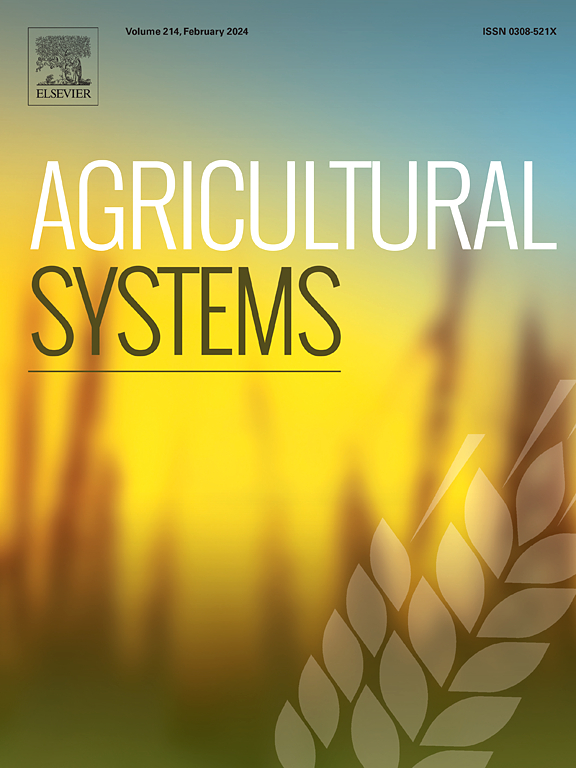Looks matter? Field performance and farmers' preferences for drought-tolerant maize in Kenya
IF 6.1
1区 农林科学
Q1 AGRICULTURE, MULTIDISCIPLINARY
引用次数: 0
Abstract
Context
To help farmers adapt to climate change, breeding programs have developed drought-tolerant (DT) maize varieties, but varietal turnover among smallholder farmers is slow. One possible reason for low adoption is that DT varieties produce higher yields than older hybrid maize varieties but are not visibly more drought tolerant, especially if morphology is a factor in farmers' varietal choice.
Objectives
Motivated by this conjecture, our first objective is to compare the drought tolerance of a new hybrid DT maize variety and older varieties under farmer-managed conditions in terms of both morphology and yields. Our second objective is to analyze whether increasing farmers' exposure to this variety increases their awareness of its DT traits and subsequent adoption.
Methods
We leverage a project that provided seed trial packs of a new DT maize variety to randomly selected farmers in seven counties in Kenya with varying rainfall conditions. Picture-based crop monitoring across two seasons yielded a novel panel dataset of 18,225 smartphone images labeled for drought damage, and, for a subsample of fields, yields. We use this dataset to compare the performance of promoted and commonly grown varieties. We then use exogenous variation in receiving trial packs to analyze how providing trial packs affects varietal preferences and adoption.
Results and conclusion
The promoted variety produces higher yields than other varieties. Under good conditions, it also appears visibly less damaged during the flowering stage, but morphological differences disappear under more severe moisture stress, and once the crop reaches maturity. Consistent with these observations, treatment farmers do not perceive this variety to be more drought tolerant than other varieties and are more likely to plant the promoted variety only when receiving a free trial pack.
Significance
It could be that limited visibility of DT traits hinders sustained adoption. Increasing adoption of DT varieties to enhance climate change adaptation in drought-prone regions may require facilitating prolonged learning and experimentation opportunities, increasing awareness of how DT traits manifest themselves in terms of yields and morphology under varying rainfall conditions, and, costs permitting, selecting for visible DT traits in plant breeding.

看起来有关系吗?肯尼亚的田间表现和农民对耐旱玉米的偏好
为了帮助农民适应气候变化,育种项目开发了耐旱(DT)玉米品种,但小农的品种更替缓慢。采用率低的一个可能原因是,DT品种比较老的杂交玉米品种产量更高,但并不明显更耐旱,特别是当形态是农民选择品种的一个因素时。基于这一猜想,我们的第一个目标是比较一个新的DT杂交玉米品种和老品种在农民管理条件下在形态和产量方面的耐旱性。我们的第二个目标是分析增加农民对该品种的接触是否会增加他们对其DT特性的认识并随后采用。方法我们利用一个项目,向肯尼亚七个县随机选择的农民提供一种新的DT玉米品种的种子试验包,这些县的降雨条件各不相同。基于图片的作物监测跨越两个季节,产生了一个新颖的面板数据集,其中包含18,225张智能手机图像,标记为干旱损害,并为田地的子样本标记为产量。我们使用这个数据集来比较推广品种和普通品种的表现。然后,我们使用外源变异接收试包来分析提供试包如何影响品种偏好和采用。结果与结论推广品种产量高于其他品种。在良好的条件下,花期损伤也明显减少,但在更严重的水分胁迫下,一旦作物成熟,形态差异就会消失。与这些观察结果一致的是,处理农民并不认为该品种比其他品种更耐旱,只有在收到免费试用包时才更有可能种植推广品种。可能是DT特征的有限可见性阻碍了持续的采用。为了提高干旱易发地区对气候变化的适应能力,可能需要增加学习和实验机会,提高对不同降雨条件下DT性状在产量和形态方面的表现的认识,以及在成本允许的情况下,在植物育种中选择可见的DT性状。
本文章由计算机程序翻译,如有差异,请以英文原文为准。
求助全文
约1分钟内获得全文
求助全文
来源期刊

Agricultural Systems
农林科学-农业综合
CiteScore
13.30
自引率
7.60%
发文量
174
审稿时长
30 days
期刊介绍:
Agricultural Systems is an international journal that deals with interactions - among the components of agricultural systems, among hierarchical levels of agricultural systems, between agricultural and other land use systems, and between agricultural systems and their natural, social and economic environments.
The scope includes the development and application of systems analysis methodologies in the following areas:
Systems approaches in the sustainable intensification of agriculture; pathways for sustainable intensification; crop-livestock integration; farm-level resource allocation; quantification of benefits and trade-offs at farm to landscape levels; integrative, participatory and dynamic modelling approaches for qualitative and quantitative assessments of agricultural systems and decision making;
The interactions between agricultural and non-agricultural landscapes; the multiple services of agricultural systems; food security and the environment;
Global change and adaptation science; transformational adaptations as driven by changes in climate, policy, values and attitudes influencing the design of farming systems;
Development and application of farming systems design tools and methods for impact, scenario and case study analysis; managing the complexities of dynamic agricultural systems; innovation systems and multi stakeholder arrangements that support or promote change and (or) inform policy decisions.
 求助内容:
求助内容: 应助结果提醒方式:
应助结果提醒方式:


